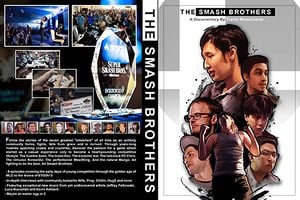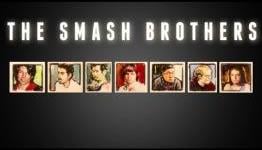The Smash Brothers
The Smash Brothers is a 9-episode documentary series produced by Travis "Samox" Beauchamp. The series was released in October 2013, shortly after what was then the largest Melee tournament of all time: EVO 2013.
The series focuses on seven professional smashers who were active in the 2003-2013 period, labelled by the documentary as the greatest Melee players of all time: Azen, Isai, Ken, PC Chris, KoreanDJ, Mew2King, and Mango. The documentary additionally describes the origins, growth and metagame of the Melee competitive scene, and community efforts to keep the scene thriving into later generations of video game consoles, beyond the discontinuation of the GameCube.
The series thus covers the "Golden Era of Smash" (2003-2008), which is told over seven episodes, with the remaining two episodes detailing the community's history in the lead-up to EVO 2013. This history is told through primary sources, particularly video footage and photographs from the period, as well as interviews of several members of the Smash community who were active at the time.
The entire series is available for free on YouTube, including a remastered version released in November 2013. It has been credited with a surge in Melee's popularity since its release, with some members of the community labeling the incoming generation of players as "Doc Kids".
Episodes
| # | Title | Remastered | Tagline | Highlighted Smasher |
|---|---|---|---|---|
| 1 | Show Me Your Moves | Link | The world of competitive Melee is introduced through a sting operation. | N/A |
| 2 | No Johns | Link | The Master of Diversity takes on the King of the West. | Azen |
| 3 | Don't Get Hit | Link | The showdown between Ken and Isai. | Isai |
| 4 | The King of Smash | Link | The Era of Ken. | Ken |
| 5 | Revolution | Link | A new challenger arises. | PC Chris |
| 6 | Paper Cuts | Link | The master of overkill rockets to the biggest stage in Melee history. | KoreanDJ |
| 7 | The Robot | Link | One thing above everything else: Perfection. | Mew2King |
| 8 | The Natural | Link | The story of FC Legacy. | Mang0 |
| 9 | Game! | Link | Melee returns to its rightful place. | N/A |
Production
The documentary was produced over two years[1] for a total budget of $12,000. Around $7,000 was driven by community donations, including $4,000 through a Kickstarter campaign.[2].
Smashers interviewed
Other Episodes
Metagame
Metagame is a documentary series follow-up that covers the "Five Gods of Melee," funded with a Kickstarter of $34,583.[3] On November 23rd, 2020, a trailer released, along with the announcement that the series would premiere on Twitch on December 11th-13th, 2020.[4] Episodes 1-3 aired on December 11th at 2-5 p.m. PT, Episodes 4-6 aired on December 12th at 2-5 p.m. PT, and Episodes 7-8 aired on December 13th at 2-4 p.m. PT.
Reception and legacy
The Smash Brothers is largely credited for growing what would become the modern Melee tournament scene. Since then, it's been credited as among the best esports documentaries of all time by news outlets, resulting in a spectator culture that has continued to grow well into the modern day.[5]
The Smash Brothers's representation of Brawl has received criticism over the years, being credited with doing irreversible damage to the game's reputation. Specifically, issues taken are with the use of low-level footage when representing Brawl's problems instead of high-level footage of the time, acting as though the game lacked a significant competitive scene, as well as the lack of opposing views. Samox covered this in an episode of Samox Talks,[6] where he owns the original documentary's criticisms, saying that the points given were meant to fit with the narrative of the game and documentary, rather than praise Brawl and illustrate a community divide that had yet to become what is seen today.
'Doc Kids'
Doc Kids are the new generation of players who, as Tafokints put it, "basically represent people who got into the game after Aug 2013 in light of the Smash Documentary". With the end of the documentary based around EVO 2013, the tournament marked the dawn of a new age in Melee. The media interest in the event as well as the documentary helped draw in members to the Melee community almost exponentially. Fiction theorized that - given 3 years of directed effort - a player could reach 'top-100' status. This has been proven by several players who began playing post-documentary, namely;
- Zain (Began playing in May 2014 - The first 'Doc Kid' to win a major tournament, doing so at Shine 2018, and is widely regarded as one of the greatest, if not the greatest, Melee player in the post-Netplay era)
- Cody Schwab (Began playing in September 2015 - Ranked as the best player in the world in 2023)
- Jmook (Began playing in October 2014 - One of the best players in the post-Netplay era, peaking at 3rd on the SSBMRank 2023)
- moky (Began playing in 2014 - Peaked at 4th on the SSBMRank 2023)
- Soonsay (Began playing in 2017 - Peaked at 9th on SSBMRank Summer 2024)
- Spark (Began playing in January 2014 - Peaked at 12th on SSBMRank Summer 2024)
- KoDoRiN (Began playing in 2017 - Peaked at 11th on the SSBMRank 2023)
- Magi (Began playing in March 2015 - Peaked at 17th on the SSBMRank 2023)
References
- ^ https://www.reddit.com/r/smashbros/comments/1ssxjn/hello_all_samox_here_creator_of_the_smash/ce12k3i/?context=3
- ^ https://www.reddit.com/r/smashbros/comments/1ssxjn/hello_all_samox_here_creator_of_the_smash/ce11v84/?context=10000
- ^ https://www.kickstarter.com/projects/eastpointpictures/the-smash-brothers-armada
- ^ https://www.metagamedoc.com/
- ^ The Smash Brothers' might be the best eSports documentary of all time
- ^ Samox Talks 1: Brawl's Depiction in "The Smash Brothers"
| Significant events in competitive Smash history | |
|---|---|
| 2000s | Wombo Combo |
| 2010s | Release of The Smash Brothers · Leffen vs. Chillin (Apex 2015) · Super Pichu cheating scandal |
| 2020s | COVID-19 pandemic · Sexual misconduct allegations · Cancellation of The Big House Online · Cancellation of Smash World Tour 2022 · Nintendo Community Tournament Guidelines |

